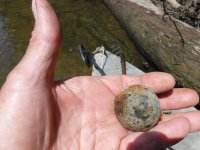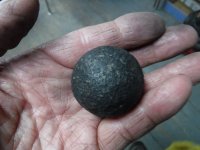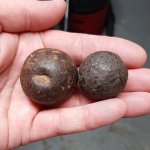A few years ago I was reading local history and it mentioned that there was a war of 1812 depot across the river and north of my local town. After much research I found that this was true although the location had been lost to time. For several years I searched and last year I received permission to search a new field and did start finding early relics relating to the war of 1812. I found a large number of musket balls and buckshot as well as artillery buttons and gun flints and several lead pads for the flints and many early iron items. This summer I started detecting the river in front of the depot and just recovered a good sized iron ball. The ball is 1.5" in diameter and has a weight of 8oz. After some research I found that case shot for 24lb artillery is of the same dimension and weight. I'm thinking that is what I have found and am looking for opinions. The two pictures are of the ball right after recovery and again after being cleaned and run through electrolysis. The ball is perfectly round with no seams. Thoughts?
You are using an out of date browser. It may not display this or other websites correctly.
You should upgrade or use an alternative browser.
You should upgrade or use an alternative browser.
✅ SOLVED Are there any War of 1812 experts out there?
- Thread starter whites m6
- Start date
Beeps in my sleep
Hero Member
- Sep 6, 2013
- 668
- 782
- Detector(s) used
- Whites 6000, Fisher F2, Garrett AT Pro, XP Deus
- Primary Interest:
- All Treasure Hunting
CannonBallGuy.. you are up  . You can spot the difference between mill balls, cannon ball, and others. WhitesM6 give him some time and you will get some very in depth knowledge. Since you gave weight and measurements, I am sure he will have an answer for you. Good Luck and REALLY COOL find either way!
. You can spot the difference between mill balls, cannon ball, and others. WhitesM6 give him some time and you will get some very in depth knowledge. Since you gave weight and measurements, I am sure he will have an answer for you. Good Luck and REALLY COOL find either way!
 . You can spot the difference between mill balls, cannon ball, and others. WhitesM6 give him some time and you will get some very in depth knowledge. Since you gave weight and measurements, I am sure he will have an answer for you. Good Luck and REALLY COOL find either way!
. You can spot the difference between mill balls, cannon ball, and others. WhitesM6 give him some time and you will get some very in depth knowledge. Since you gave weight and measurements, I am sure he will have an answer for you. Good Luck and REALLY COOL find either way!
Upvote
3
- Dec 30, 2012
- 7,433
- 13,996
- 🏆 Honorable Mentions:
- 2
- Detector(s) used
- Presently using Deus 2's & have Minelabs, Nokta's Tesoro's DEus's Have them all . Have WAY to many need to get rid of some
- Primary Interest:
- All Treasure Hunting
Send a message to Hunter1805 He is EXTREMELY knowledgeable in that time frame
Upvote
2
TheCannonballGuy
Gold Member
- Feb 24, 2006
- 6,542
- 13,069
- Detector(s) used
- White's 6000, Nautilus DMC-1, Minelab
- Primary Interest:
- Relic Hunting
My analysis is based on the ball's 1.5" diameter and 8-ounce weight measurements you reported. Whoever told you the ball is a "24-Pounder (5.82" caliber) Case-Shot ball" is seriously incorrect. A Case-Shot shell is filled with antipersonnel balls or slugs or wedges, etc. The balls in a 24-Pdr. Case-Shot were approximately .65 to .75-inch in diameter... and were almost always made of lead. (The Confederates ran short of lead in very-early-1863 and had to use iron for case-shot balls from then on through the end of the war.)
The US Ordnance Manual of 1861 contains super-precise diameter and weight measurements charts (called the "Shot Tables") for artillery balls used from the Revolutionary War through the civil war.
www.civilwarartillery.com/shottables.htm
The closest matchup for your 1.5-inch 8-ounce iron ball in the Shot Tables is a 12-Pounder Field Gun's Canister-Ammo ball... which was 1.465-to-1.485-innches in diameter and weighed .43-pound (7 ounces). If your ball actually does measure PRECISELY 1.5" in diameter and weigh PRECISELY 8-ounces (instead of 7), it is not an Artillery ball, it is a Civilian-usage ball (such as a ball-bearing). I emphasized the word PRECISELY because to achieve CERTAINTY of identification you will need to use "precision" measuring devices -- such as a Caliper which measure in hundredths-of-an-inch, and a Postal Shipping scale, which weighs in tenths-of-an-ounce.
The US Ordnance Manual of 1861 contains super-precise diameter and weight measurements charts (called the "Shot Tables") for artillery balls used from the Revolutionary War through the civil war.
www.civilwarartillery.com/shottables.htm
The closest matchup for your 1.5-inch 8-ounce iron ball in the Shot Tables is a 12-Pounder Field Gun's Canister-Ammo ball... which was 1.465-to-1.485-innches in diameter and weighed .43-pound (7 ounces). If your ball actually does measure PRECISELY 1.5" in diameter and weigh PRECISELY 8-ounces (instead of 7), it is not an Artillery ball, it is a Civilian-usage ball (such as a ball-bearing). I emphasized the word PRECISELY because to achieve CERTAINTY of identification you will need to use "precision" measuring devices -- such as a Caliper which measure in hundredths-of-an-inch, and a Postal Shipping scale, which weighs in tenths-of-an-ounce.
Last edited:
Upvote
10
- Thread starter
- #5
Good information, I will check further and let you know. Thank you!My analysis is based on the ball's 1.5" diameter and 8-ounce weight measurements you reported. Whoever told you the ball is a "24-Pounder Case-Shot ball is seriously incorrect. A "Case-Shot" shell is filled with antipersonnel balls or slugs or wedges, etc. The balls in a 24-Pdr. Case-Shot were approximately .65 to .75-inch in diameter... and were almost always made of lead. (The Confederates ran short of lead in very-early-1863 and had to use iron for case-shot balls from then on through the end of the war.
The US Ordnance Manual of 1861 contains super-precise diameter and weight measurements charts (called the "Shot Tables") for artillery balls used from the Revolutionary War through the civil war.
www.civilwarartillery.com/shottables.htm
The closest matchup for your 1.5-inch 8-ounce iron ball in the Shot Tables is a 12-Pounder Napoleon gun Canister-Ammo ball... which was 1.465-to-1.485-innches in diameter and weighed .43-pound (7 ounces). If your ball actually does measure PRECISELY 1.5" in diameter and weigh PRECISELY 8-ounces (instead of 7), it is not an Artillery ball, it is a Civilian-usage ball (such as a ball-bearing). I emphasized the word PRECISELY because to achieve CERTAINTY of identification you will need to use "precision" measuring devices -- such as a Caliper which measure in hundredths-of-an-inch, and a Postal Shipping scale, which weighs in tenths-of-an-ounce.
Upvote
3
- Thread starter
- #6
My analysis is based on the ball's 1.5" diameter and 8-ounce weight measurements you reported. Whoever told you the ball is a "24-Pounder (5.82" caliber) Case-Shot ball" is seriously incorrect. A Case-Shot shell is filled with antipersonnel balls or slugs or wedges, etc. The balls in a 24-Pdr. Case-Shot were approximately .65 to .75-inch in diameter... and were almost always made of lead. (The Confederates ran short of lead in very-early-1863 and had to use iron for case-shot balls from then on through the end of the war.)
The US Ordnance Manual of 1861 contains super-precise diameter and weight measurements charts (called the "Shot Tables") for artillery balls used from the Revolutionary War through the civil war.
www.civilwarartillery.com/shottables.htm
The closest matchup for your 1.5-inch 8-ounce iron ball in the Shot Tables is a 12-Pounder Field Gun's Canister-Ammo ball... which was 1.465-to-1.485-innches in diameter and weighed .43-pound (7 ounces). If your ball actually does measure PRECISELY 1.5" in diameter and weigh PRECISELY 8-ounces (instead of 7), it is not an Artillery ball, it is a Civilian-usage ball (such as a ball-bearing). I emphasized the word PRECISELY because to achieve CERTAINTY of identification you will need to use "precision" measuring devices -- such as a Caliper which measure in hundredths-of-an-inch, and a Postal Shipping scale, which weighs in tenths-of-an-ounce.
I measured the ball with a caliper today and it came in at 1.525" and weight on a postal scale is almost exactly 8 ounces so unfortunately it would seem I have an iron ball of some type. Thank you again for the information!My analysis is based on the ball's 1.5" diameter and 8-ounce weight measurements you reported. Whoever told you the ball is a "24-Pounder (5.82" caliber) Case-Shot ball" is seriously incorrect. A Case-Shot shell is filled with antipersonnel balls or slugs or wedges, etc. The balls in a 24-Pdr. Case-Shot were approximately .65 to .75-inch in diameter... and were almost always made of lead. (The Confederates ran short of lead in very-early-1863 and had to use iron for case-shot balls from then on through the end of the war.)
The US Ordnance Manual of 1861 contains super-precise diameter and weight measurements charts (called the "Shot Tables") for artillery balls used from the Revolutionary War through the civil war.
www.civilwarartillery.com/shottables.htm
The closest matchup for your 1.5-inch 8-ounce iron ball in the Shot Tables is a 12-Pounder Field Gun's Canister-Ammo ball... which was 1.465-to-1.485-innches in diameter and weighed .43-pound (7 ounces). If your ball actually does measure PRECISELY 1.5" in diameter and weigh PRECISELY 8-ounces (instead of 7), it is not an Artillery ball, it is a Civilian-usage ball (such as a ball-bearing). I emphasized the word PRECISELY because to achieve CERTAINTY of identification you will need to use "precision" measuring devices -- such as a Caliper which measure in hundredths-of-an-inch, and a Postal Shipping scale, which weighs in tenths-of-an-ounce.
Upvote
3
Looks like you have a great spot there! Great job on being persistent.A few years ago I was reading local history and it mentioned that there was a war of 1812 depot across the river and north of my local town. After much research I found that this was true although the location had been lost to time. For several years I searched and last year I received permission to search a new field and did start finding early relics relating to the war of 1812. I found a large number of musket balls and buckshot as well as artillery buttons and gun flints and several lead pads for the flints and many early iron items. This summer I started detecting the river in front of the depot and just recovered a good sized iron ball. The ball is 1.5" in diameter and has a weight of 8oz. After some research I found that case shot for 24lb artillery is of the same dimension and weight. I'm thinking that is what I have found and am looking for opinions. The two pictures are of the ball right after recovery and again after being cleaned and run through electrolysis. The ball is perfectly round with no seams. Thoughts?
Upvote
1
- Thread starter
- #8
Thanks, lots of good land finds just above this river spot. 84 buttons, 17 coins, several knives in pieces, a jar of musket balls and 3 buckets full of iron items. Everything dates from the War of 1812 to around 1850. The spot was used as a home site after the depot was gone. Also found to date are 21 Indian points and a stone ax on the same spot.Looks like you have a great spot there! Great job on being persistent.
Upvote
3
Just a thought TCB... what first came to my mind was War of 1812 Grapeshot.My analysis is based on the ball's 1.5" diameter and 8-ounce weight measurements you reported. Whoever told you the ball is a "24-Pounder (5.82" caliber) Case-Shot ball" is seriously incorrect. A Case-Shot shell is filled with antipersonnel balls or slugs or wedges, etc. The balls in a 24-Pdr. Case-Shot were approximately .65 to .75-inch in diameter... and were almost always made of lead. (The Confederates ran short of lead in very-early-1863 and had to use iron for case-shot balls from then on through the end of the war.)
The US Ordnance Manual of 1861 contains super-precise diameter and weight measurements charts (called the "Shot Tables") for artillery balls used from the Revolutionary War through the civil war.
www.civilwarartillery.com/shottables.htm
The closest matchup for your 1.5-inch 8-ounce iron ball in the Shot Tables is a 12-Pounder Field Gun's Canister-Ammo ball... which was 1.465-to-1.485-innches in diameter and weighed .43-pound (7 ounces). If your ball actually does measure PRECISELY 1.5" in diameter and weigh PRECISELY 8-ounces (instead of 7), it is not an Artillery ball, it is a Civilian-usage ball (such as a ball-bearing). I emphasized the word PRECISELY because to achieve CERTAINTY of identification you will need to use "precision" measuring devices -- such as a Caliper which measure in hundredths-of-an-inch, and a Postal Shipping scale, which weighs in tenths-of-an-ounce.
I dug a few of these 'grapeshot' when I lived in Toronto. The Americans bombarded Toronto (then known as the 'British-held' Town of York) from ships in Lake Ontario during the War of 1812.
Here's the example of one I found (shown on the left) beside an unidentified 'iron ball' I found years later on a different site.
Dave
Attachments
Upvote
2
ARC
Gold Member
- Aug 19, 2014
- 37,248
- 131,547
- Detector(s) used
- JW 8X-ML X2-VP 585
- Primary Interest:
- All Treasure Hunting
Agreed... grapeshot.Just a thought TCB... what first came to my mind was War of 1812 Grapeshot.
I dug a few of these 'grapeshot' when I lived in Toronto. The Americans bombarded Toronto (then known as the 'British-held' Town of York) from ships in Lake Ontario during the War of 1812.
Here's the example of one I found (shown on the left) beside an unidentified 'iron ball' I found years later on a different site.
Dave
Upvote
2
- Thread starter
- #11
That is interesting! I live not far from where the 1813 Battle of Lake Erie was fought. I have original writings calling for supplys from what I believe is the depot that I have found. I know some of the US ships had 24lb cannons and sometimes fired grape shot. That's not to say what I have found is related but it is in the right spot.Just a thought TCB... what first came to my mind was War of 1812 Grapeshot.
I dug a few of these 'grapeshot' when I lived in Toronto. The Americans bombarded Toronto (then known as the 'British-held' Town of York) from ships in Lake Ontario during the War of 1812.
Here's the example of one I found (shown on the left) beside an unidentified 'iron ball' I found years later on a different site.
Dave
Last edited:
Upvote
1
Top Member Reactions
-
 2586
2586 -
 1138
1138 -
 1063
1063 -
 901
901 -
 882
882 -
 848
848 -
 805
805 -
 695
695 -
 633
633 -
 551
551 -
 489
489 -
 478
478 -
 477
477 -
 464
464 -
 462
462 -
O
433
-
 428
428 -
 391
391 -
 380
380 -
 361
361
Users who are viewing this thread
Total: 2 (members: 0, guests: 2)







